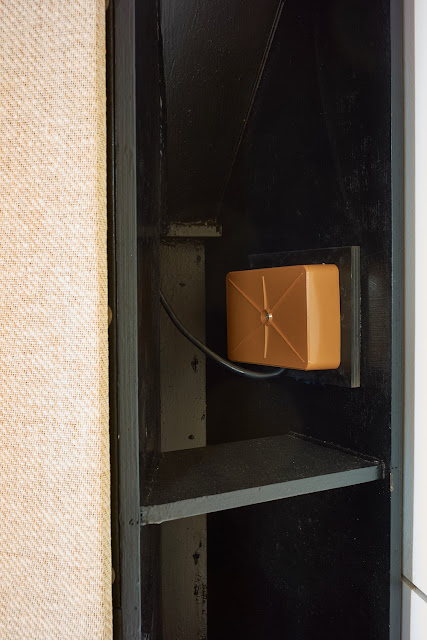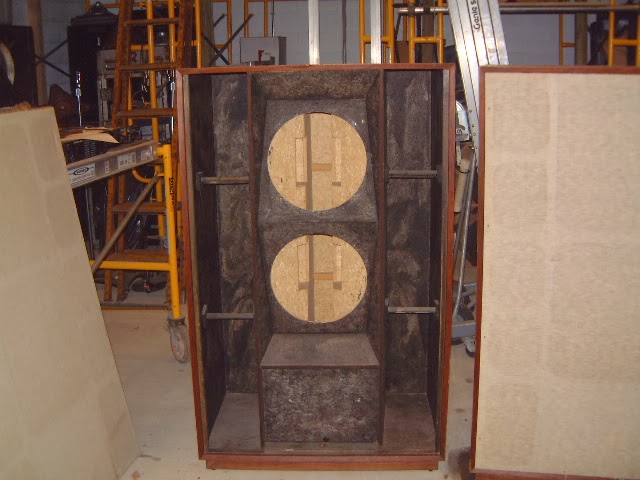To remember some month ago back, Klaus experimented with different stages of internal damping of the backloaded horn. The compression chamber was main part of this tests, but as well the beginning of the horn development. He did experiment with damping of its openings, which did find its final damping with the dedicated covers (i.e. grill cloth, decoration bars and the holding panels). To me unbelievable, he worked out that the enclosures need the side covers installed, otherwise the Lf-part of the spectrum was more than prominent.
 |
| In final position, the Tannoy Autograph enclosures driven from Maihak V53 EL11 PP amplifier |
 |
| View into the uncovered side openings of the horn development, all damping materials have been removed. |
Our Christmas audition started at the first glance with a optimized overall neutral tonality, which I had not heard before in Klaus system with these speakers. For this neutrality several improvements have been made, some did take place in the amplifying chain in order to optimize the signal quality. Others came from further improvements with the damping of the compression chamber of the enclosures.
In the late afternoon of Christmas evening we had started to listen with Chico Freemans Spirit Sensitive, reissued from Analogue Production in perfect quality some years ago, like always the reissues of that early time are better than perfect and top always the original releases. We switched after a while to Chet Bakers Let's get lost, a mid 1980ties recording with extremely well preserved fine modulation of the tonal dynamics. Both records I do use regulary within my own setup, so I know them extremely well. The latter one is known to me as almost invisible holographic presentation, showing not even the smallest remnant of electronic errors like phase shifts or typical hardening of some frequency edges. Today it presents a extended low frequency response, with fast, deep transient response. But as well a mild softening of the upper mids was audible, the overall tonality showed some little woolliness in this region. All records we did listened to, did show this same tonal effect. So it was obvious, that this was a characteristic which had taken place. A quick switch to digital sources showed a much more linear response here, without any woolliness, two more Cds did confirm the impression. So it was quite obvious that the found deviation was not a inlinearity of the Autograph speakers, it must be something coming from his analogue deemphasis and amplification chain.
 |
| Some records used within our audition at Christmas Evening 2013 |
In the last month Klaus has made some service at his RIAA equalizer. He uses a double mono set of customized Telefunken V87 studio modules original used for tape recorders, modified after Neumann WV2a design for his RIAA equalization. The Neumann units are designed with similar tubes, output transformers and PSU, but have selectable deemphasis curves. Klaus implemented only the Neumann RIAA filter for his use. Here some electrolytics and resistors had run out tolerance and were in the need of exchange. He selected some pio caps and carbon resistors to close as possible tolerances and for stereo matching. He had to replace almost all components within the filter unit. He did measure the final result with his oscilloscope and further measurement equipment and stated that the equalizer now is back to closest tolerances of the ideal RIAA curve. From my personal experience pio caps sound inferior to any other capacitor made, even within passive RIAA equalization filters, but they add a very typical fingerprint to the sound. Together with the preferred natural smoothness, they lower the audible effect the hf-deempasis. Even with perfect measurements, the sound of the correction seems to low. A lot of users would replace the capacitors for compound foil types, I never did like these and would suggest to keep the positive advantages of the pio caps, instead I would adwise a readjustment of the filter to get rid of the unwanted effect.
 |
| Telefunken V87 amplifiers, here customized to Neumann WV2a design with RIAA deemphasis curve, since the original offers switchable alternative equalizing curves. |
 |
| Platine Verdier derivate magnet bearing record player with SME 3012/II and Ortofon SPU Gold |
A second task of the day was the collective cooking of the Christmas dinner with three courses and a lot of communication. Klaus had prepared some dear goulash some days ago, he had marinated the meat with several herbs and spices, oranges and lots of red wine for the main coarse in advance. Since I had marinated and cooked for hours the red cabbage with typical herbal ingredients like cinnamon and laurel as perfect christmas flavor. As well I did prepare some dumplings from fresh potatoes and dried bread for the main course and a creme brûlée as final end.
Together we started our cooking with some fine cut air dried spanish ham and some salad with a first glass of Brunello di Montalcino wine.
One of the first records of Brunello was a red wine that was made in the Montalcino area in the early 14th century. In 1831, marchese Cosimo Ridolfi (who was later appointed Prime Minister of Tuscany by the Grand Duke Leopold II) praised the merits of the red wines of Montalcino above all others in Tuscany. In 1865, an agricultural fair in Montalcino noted that the prize winning wine of the event was a "select red wine" known as a Brunello. In the mid-19th century, a local farmer named Clemente Santi isolated certain plantings of Sangiovese vines in order to produce a 100% varietal wine that could be aged for a considerable period of time. In 1888, his grandson Ferruccio Biondi-Santi-a veteran soldier who fought underGiuseppe Garibaldi during the Risorgimento-released the first "modern version" of Brunello di Montalcino that was aged for over a decade in large wood barrels.When the dear goulash was set into the oven, we had time again to combine our enjoyments upstairs for further listening to other records. When the meat had roasted to finished stage in the oven (2 hours), we completed it with my side dishes for main course. We were eating and talking for more than two hours before we continued listening to music with another bottle of the Brunello. We completed the evening (and the most of the night) with further music and talks. I demonstrated Klaus my headshell tests and we used two SPU pick ups beside his own SPU Gold for evaluation of the differences in materials. We finished very late (or lets say early) with the agreement, that the Autograph speakers now have lost their former problems and are working nicely beyond any other Tannoy enclosure Klaus has owned before. At 4h o'clock in the night I did fall almost asleep in the listening room, so I realized that I will need some sleep soon.
By the end of World War II, Brunello di Montalcino had developed a reputation as one of Italy's rarest wines. The only commercial producer recorded in government documents was the Biondi-Santi firm who had declared only four vintages up to that point-1888, 1891, 1925 and 1945. The high price and prestige of these wines soon encouraged other producers to emulate Biondi-Santi's success. By the 1960s there were 11 producers making Brunello, and in 1968 the region was granted Denominazione di Origine Controllata (DOC) status. By 1970 the number of producers had more than doubled to 25, and by 1980 there were 53 producers. In 1980, the Montalcino region was the first Italian wine region to be awarded Denominazione di Origine Controllata e Garantita (DOCG) designation. By the turn of the 21st century, there were nearly 200 producers of Brunello di Montalcino, mostly small farmers and family estates, producing nearly 330,000 cases a year.By the end of World War II, Brunello di Montalcino had developed a reputation as one of Italy's rarest wines. The only commercial producer recorded in government documents was the Biondi-Santi firm who had declared only four vintages up to that point-1888, 1891, 1925 and 1945. The high price and prestige of these wines soon encouraged other producers to emulate Biondi-Santi's success. By the 1960s there were 11 producers making Brunello, and in 1968 the region was granted Denominazione di Origine Controllata (DOC) status. By 1970 the number of producers had more than doubled to 25, and by 1980 there were 53 producers. In 1980, the Montalcino region was the first Italian wine region to be awarded Denominazione di Origine Controllata e Garantita (DOCG) designation. By the turn of the 21st century, there were nearly 200 producers of Brunello di Montalcino, mostly small farmers and family estates, producing nearly 330,000 cases a year.
 |
| Frontloaded Horn opening with 15'' Tannoy Monitor Gold Speakers, a unique and tremendously important design feature for the Tannoy Dual Concentric principle. |
I am sure Klaus will refine the last problems in his analogue rail and afterwards he has found after 30 years his final loudspeaker. Thanks to the powerful attributes of the horn loading principle, here with respect to a front loading funnel and a long folded back loading horn enclosure, extended by flanking room walls, the speakers convince with a rare quality of response. They are a tremendous efficient system, able to transmit almost natural dynamics of real instruments with low power tube amplification.
Of course these "instruments" are not every bodies "cup of tea", they are expensive and their room preferences will limit the club of owners with a natural choice. Which means, the listening room must have a ideal geometry and size to make this particular design work. If you are willing to match such conditions, the Autograph enclosures may be the best vintage speaker enclosure for the imcomparable dual concentric loudspeaker from the Tannoy line. And they will work even very well without the wine from Montalcino....
Read on next week for my new enclosures for the Tannoy line, Volker











